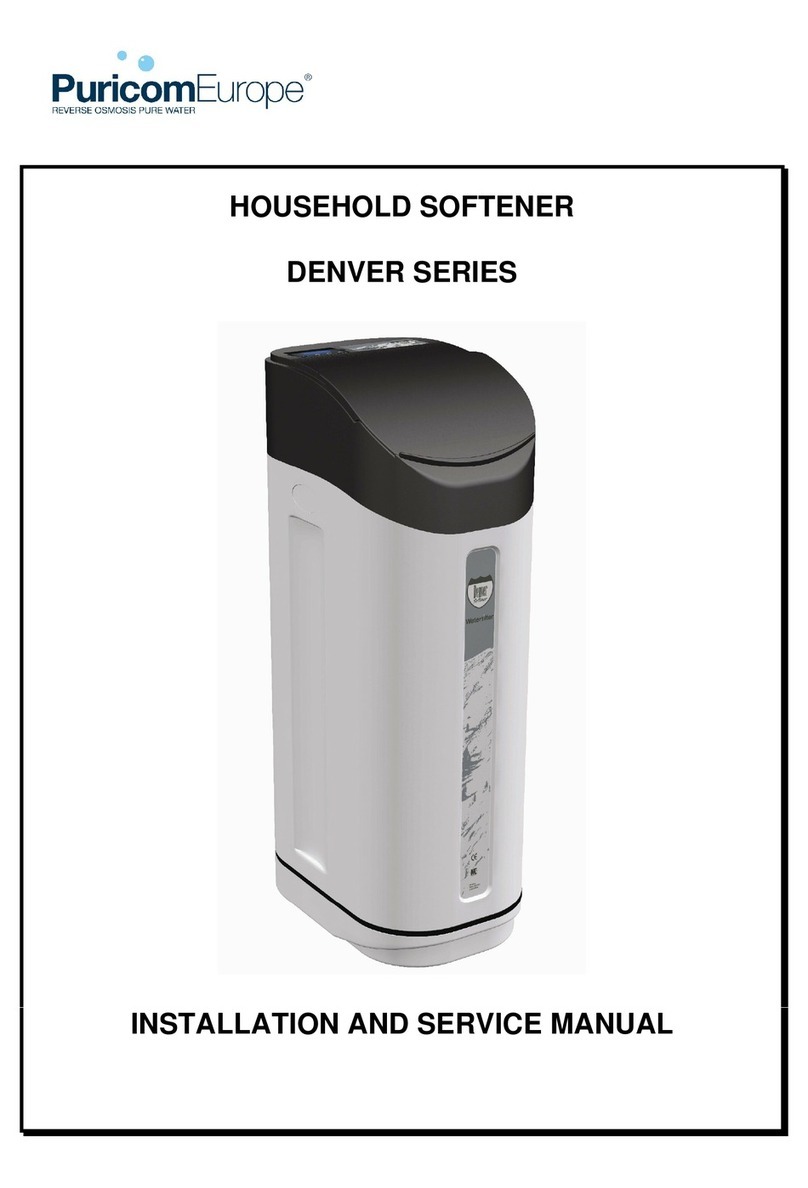8
5. WARNINGS
The water treatment equipments serie Denver are not intended
to be used to produce POTABLE WATER. Their function is to eli-
minate the hardness of the water obtaining a treated softened water that
will avoid all problems related to hard water.
If the treated water does not come from a public net or it is
from an unknown source it will be necessary to carry out a phy-
sical- chemical and bacteriological test in order to ensure the correct
potabilization as per tecniches and systems needed (BEFORE the system
is INSTALLED). Please contact you distributor and he will recommend you
the most suitable treatment according to your needs.
5.1 Requirements for the proper working of
the system
• Do not supply hot water (T>36ºC) to the system.
• The temperature must be between 4ºC and 45ºC.
• If posible the system must be installed in a dry
environment,free of acid vapors. At the same time a proper
ventilation must be insured.
• The minimum pressure should be of 2,5 bars, and if this
is not possible you should install a pressurization system that
allows to get a proper pressure.
• If the inlet pressure is higher than 5,5 bars you should install
a pressure regulator
• The water treated should be filtered so it is recommended
the installation of a previous filter in order to remove the sus-
pended particles that can be found in the inlet water. It is
recommended the use of a filtration kit code 795600, that
includes all necessary components
If a suitable filtered is not installed these suspended particles
could block the holes and the inner injectors of the system and
could affect the proper working of the same.
5.2 Installation
•To condition all water at home, install the water softener
close to the water supply inlet, and before all other plumbing
connections. Outside faucets should remain on hard water
to avoid wasting conditioned water and salt. In any case and
considering the sodium increase in softened water, it is not
recommended its use for watering because it can damage
the growing of plants and vegetables.
• In case of having to prepare the place for the installation of
the system you should follow the national laws in force regar-
ding electric and hydraulic installations.
• A drain is needed for regeneration discharge water. The
drain connection should be of free exit. The diameter of this
connection should be of minimum 1”. The máximum distance
between the softener and the floor drain should be no more
than 6 meters. A nearby drain is needed to carry away the
regeneration discharge water. A floor drain, close to the water
softener, is preferred . A laundry tub or a standpipe are other
drain options.
• The installation place should have enough room for the sys-
tem, the accessories and the connections required in order to
carry out a safe maintenance.
• In no case you will install the systems in the open air.
• Do not locate the water softener where hot temperatures
occur or near to a warm supply.
• environment where the system is installed should have all
the proper hygienic and sanitary conditions.
• All outside leakings over the system should be avoided:
plumbings, drain…
• In case of softened water supplying a hot water or steam
device, it will be necessary to install a checking valve between
the softener and the water heater in order to avoid hot water
returns that could damage the system.
• It is recommended to foresee the installation of the simple
valves for the water to be treated and for the softened water
near the softener.
• If there are quick closing valves in your installation it is re-
commended to use a non ram device.
• The softener works only on 12 volt- 50 hz electrical power
supplied by a direct plug-in transformer included. Please use
the transformer and connect it to a floor of 220 – 240 V, 50Hz.
At the same time you should be sure that the home installation
is properly protected with a device like a switch or or a fuse.
Drain hose Drain hose Drain hose
Floor drain Standpipe Laundry tube
4 cms
airgap
4 cms
airgap
5. Warnings




























